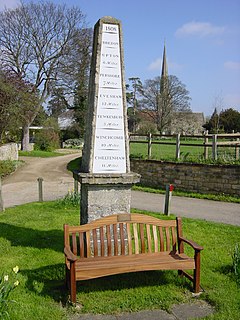Bredon's Hardwick
| Bredon | |
|---|---|
 The milestone obelisk in Bredon, with the village church of St. Giles in the background. |
|
| Bredon shown within Worcestershire | |
| Population | 2,542 |
| OS grid reference | SO925369 |
| • London | 93 miles (150 km) |
| Civil parish |
|
| District | |
| Shire county | |
| Region | |
| Country | England |
| Sovereign state | United Kingdom |
| Post town | Tewkesbury |
| Postcode district | GL20 |
| Dialling code | 01684 |
| Police | West Mercia |
| Fire | Hereford and Worcester |
| Ambulance | West Midlands |
| EU Parliament | West Midlands |
| UK Parliament | |
| Website | bredonparishcouncil.org.uk |
Bredon is a village and civil parish in Wychavon District at the southern edge of Worcestershire in England. It lies on the banks of the River Avon on the lower slopes of Bredon Hill, at "the beginning of the Cotswolds". As "Brensham Village", it has been made famous by the writer John Moore, whose descriptions of village life between the wars are widely celebrated.
Bredon is located 3 miles (5 km) north of the Gloucestershire town of Tewkesbury on the B4080 road. The River Avon forms the western boundary of the parish, and two of its tributaries, the Carrant Brook and Squitter Brook form the southern boundary.
The parish (including Bredon's Norton, formerly a separate parish to the north) extends from the Avon valley floor at an elevation of 32 feet (10 m) in the south-west to the upper slopes of Bredon Hill at an elevation of 820 feet (250 m) in the north-east. The northern third of the parish falls within the Cotswolds AONB. At its greatest extent the parish measures approximately 4.8 miles (7.7 km) long by 2.2 miles (3.5 km) wide, and covers around 4,119 acres (16.7 km2).
Bredon parish includes the hamlets of Bredon's Hardwick, Kinsham and Westmancote. At the 2011 census the parish had a population of 2,542. The parish is now combined with that of Bredon's Norton, which had a population of 247 at the 2011 census.
Bredon's history of farming and settlement goes back at least four thousand years. Archaeological remains establish that parts of the parish were settled early in the Bronze Age (2500–800 BC). There are numerous Iron Age (800 BC–100 AD) remains, some of which would have related to Kemerton Camp, a large univallate hillfort at the summit of Bredon Hill. The parish is also rich in remains from the Roman Period (43–410 AD), revealing a continuing history of settlement and farming.
...
Wikipedia

